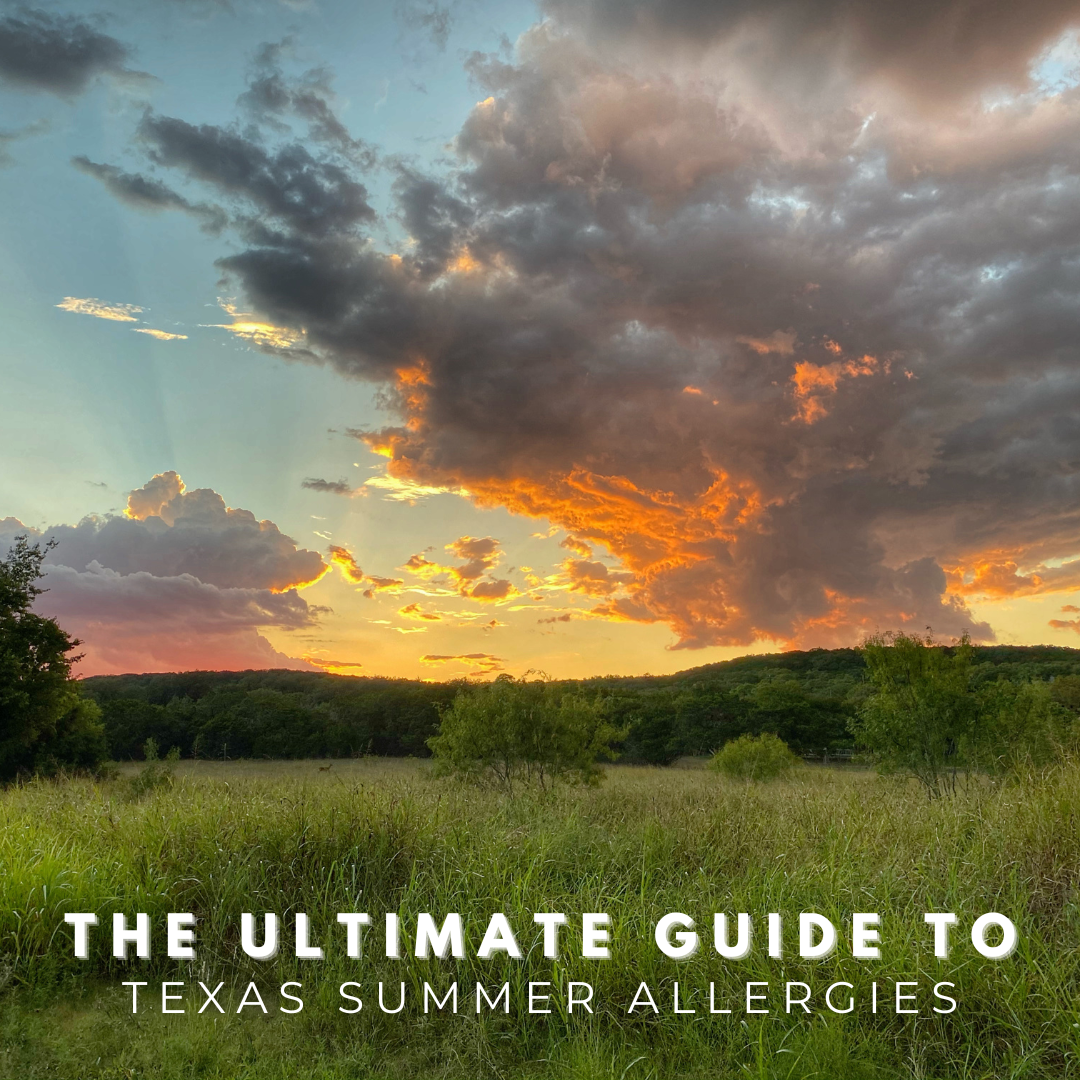Table of contents
Allergies are less common during the summer months, right? You would think so, but they can actually be worse than other times of the year. If you find yourself reaching for the tissues this summer, read on for why Texas summer allergies are so bad, which plants and environmental factors cause them, and tips to help prevent them.
Are summer allergies getting worse?
A study looking at the prevalence of hay fever between 1997-2013, showed that exposure to extreme heat events made symptoms worse. Increased temperatures and carbon dioxide cause longer pollen seasons and increase the potency of pollen as well. One study showed that pollen levels can be up to 7 times higher in a city compared to a rural area.
People living in cities are often more likely to be affected due to the urban heat island effect, where less natural landscape and more pavements and rooftops absorb heat and then emit the heat back into the environment. Urban areas are also more likely to experience more pollution and humidity, which also affects the severity of allergy sensitivity.
How common are summer allergies?
Allergies during the summer months are relatively common in Texas, due to the prevalence of mold, weeds and grasses, as well as ozone. Increased ozone or smog levels occur during warmer temperatures due to the reaction of nitrogen oxides(NOx), from burning gasoline or oil, and volatile organic compounds (VOCs), emitted from household chemicals, cars and gas stations, with UV radiation from sunlight.
Do ozone action days affect allergies?
Ozone action days are a common occurrence during the summer months in Texas and leads to decreased lung function, which can cause shortness of breath, asthma attacks, increased risk of respiratory infections and more. Studies have shown that "ozone also interacts with pollen and increases its allergenicity," due to the ability of "ozone molecules to stick to pollen surfaces and enter the respiratory tract."
What are typical summer allergy symptoms?
Common symptoms include:
- Runny or stuffy nose
- Postnasal drip
- Sneezing
- Itchy eyes, ears, nose or mouth
- Red, watery, or swollen eyes
- Irritability
- Fatigue or brain fog
- Insomnia or disturbed sleep
- Asthma symptoms may include cough, wheezing, shortness of breath or chest tightness
What types of plants and environmental factors cause summer allergies in Texas?
Trees
Cedar elm trees (Ulmus crassifolia), also known as fall elm, are native to and mostly grow in southern states including Texas, Oklahoma, Arkansas and Louisiana. It is the most common elm tree in Texas and received its name because it often grows with mountain cedar trees (Juniperus ashei). They are often used in landscaping as shade trees because they can grow up to 70 feet tall. Their leaves will turn a beautiful gold to orange-red in the fall. Cedar elm pollen season generally lasts from July through October.
Weeds

Ragweed (Ambrosia) is one of the most common environmental allergens affecting about 15% of all Americans, with symptoms ranging from mild to severe. There are 17 types of ragweed in North America, with Giant Ragweed and Western Ragweed being the most common types to grow in Texas. Ragweed commonly grows in rural areas and is often found alongside roadsides, vacant lots and fields and grows up to 3 feet tall. Texas ragweed season generally lasts between August and late November.
Pigweed (Amaranthus) is native to North America with over 60 different species found worldwide. Like ragweed, pigweed grows along roadsides and on the edges of developed areas, however pigweed can grow between 3-10 feet tall. Texas pigweed season generally lasts between July and November.
Grass

There are a wide variety of native and non-native Texas grasses, growing anywhere from 3 inches to 6 feet tall and blooming between March through December. Texas experiences longer and more potent grass seasons that can last up to 6 months, with June to August being the most severe.
Mold
Mold allergies are especially prevalent in Texas due to high levels of humidity and heat during summer months. One of the most common fungus known to trigger allergic reactions, Alternaria alternata, produces significantly more spores when in an area with high CO2. Increased temperatures also increase spore production as well. You can read more about mold allergies in Texas here.
Saharan Dust
Saharan dust is an annual weather event usually occurring between mid-June to late-August in Texas. An estimated 100 million tons of dust is picked up by wind from the African Sahara Desert and transported by seasonal trade winds over the Atlantic and into the Caribbean, affecting Puerto Rico, the US Virgin Islands and southern Continental states including Florida and Texas. The dust can cause problems for those with allergies, asthma and respiratory issues. Checking the Air Quality Index (AQI) can help to keep you informed about which days may be better to stay inside. To read more about Saharan dust in Texas, check out Saharan Dust and Texas Allergies.
What is pollen food allergy syndrome (PFAS)?
PFAS, also known as oral allergy syndrome, occurs when the immune system activates an allergic reaction due to pollen or similar proteins in certain raw foods. Symptoms can include scratchy throat, itchy mouth or swelling of the throat, tongue, lips or mouth. In less than 2% of people these symptoms may develop into anaphylaxis. The most common allergens associated with PFAS are birch, grass and ragweed. To read more about Oral Allergy Syndrome, check out How to Survive Oak Season in Texas.
When are summer allergies worst?
Summer pollen is worst in the afternoon on hot, dry days, with higher pollen production and increased ozone levels. Mold spores increase after rain and with high humidity.
Tips to prevent summer allergies
- Landscaping with native plants that are pollinator-friendly can be helpful in reducing allergies. Flowering plants pollinated by animals produce larger, heavier pollen that is less likely to be allergenic.
- Keep grass and weeds short by mowing often to prevent flowering.
- Check pollen counts to see what is causing your allergies to help prevent symptoms.
- Stay inside with windows and doors closed and a HEPA air filter, during the afternoon on dry, hot days.
- Check the AQI to be prepared for particulate matter including Saharan dust and wildfire smoke.

Natural summer allergy relief
Seasonal Allergy Formula & Mold Relief Formula
Whether you're suffering from summer trees, weeds, grasses or mold - we've got you covered! Our homeopathic formulas are safe for pets and kids, tasteless, gluten-free, dairy-free and alcohol-free with no negative side effects. Mold Relief Formula and Seasonal Allergy Formula can be taken together when multiple allergens are in the air. Don't let summer allergies keep you from enjoying the season!








